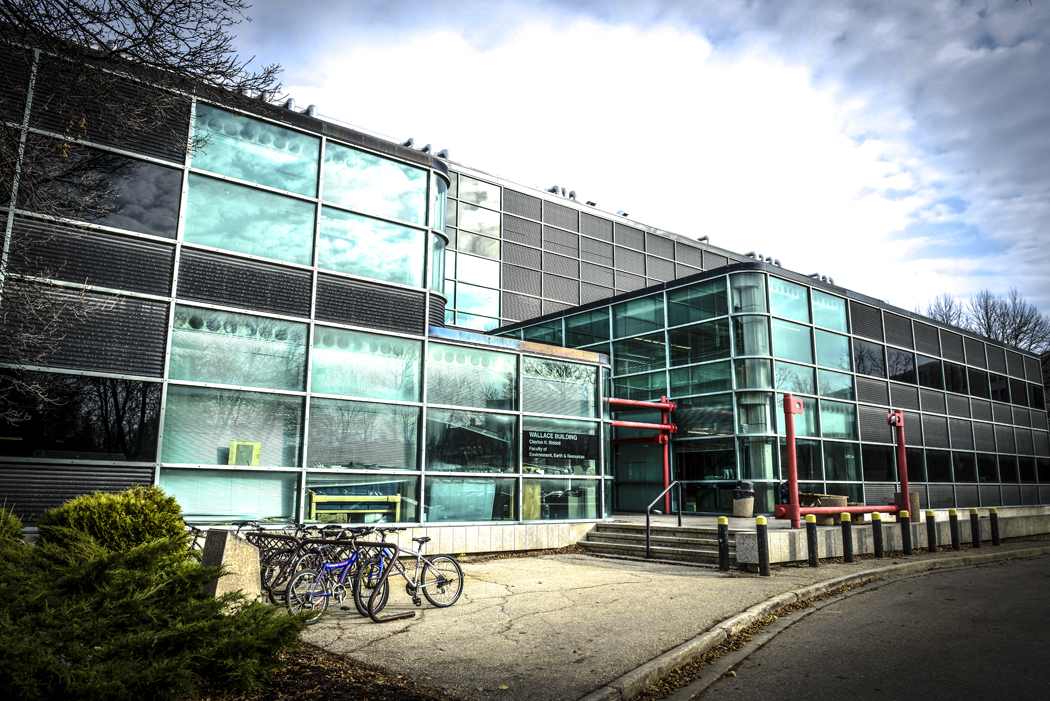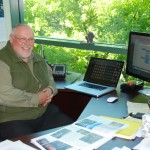
The Wallace Building, which houses the Clayton H. Riddell Faculty of Environment, Earth, and Resources.
Meet the Dean: Norman Halden
Clayton H. Riddell Faculty of Environment, Earth, and Resources
A multidimensional approach
Explaining the interdisciplinary approach of the Clayton H. Riddell Faculty of Environment, Earth, and Resources, its dean outlines its mandate as being one of connecting students to their Earth, the environment, its resources, and to the responsible use of those resources. In fact, Norman Halden sees the principle of “connectivity” as essential to an understanding of the Earth and its systems.
The Glaswegian arrived in Winnipeg 30 years ago, when the Wallace Building, which houses the faculty, was built. Involved in its planning and construction from the start, he was also there 10 years ago to plan the the current iteration of the faculty. Halden’s emphasis on the importance of the connections and complexity of the universe informs his work, both as dean and as a geologist. Rather than a reductionist approach that defines a discipline (or say, a resource) in an isolated way, the faculty has always relied on collaboration between disciplines and a multidimensional approach, says Halden.
He uses the example of the work of faculty members such as Feiyue Wang, Søren Rysgaard and Tim Papakyriakou, on sea ice systems and the mineral ikaite, a calcium carbonate mineral with a potentially huge significance for the global carbon cycle. The rare mineral is changing our understanding of the environmental degradation of Arctic sea ice, since it’s been found that one of the mineral’s characteristics is to sequester carbon dioxide. If the sea ice goes, releasing the formerly ice-trapped ikaite crystals, so potentially does the mineral’s work to reduce CO2’s harmful effects.
The point is that the study of the mineral and its characteristics is part of a larger inquiry into how it fits into the sea ice dynamic, and includes key concerns about its effects for climate and climate change, as well as for marine life.
The Clayton H. Riddell Faculty of Environment, Earth, and Resources is celebrating its 10th anniversary. About its future, Halden says, “The faculty is looking outwards. We have a lot to contribute to the sustainable and equitable development of Manitoba’s resources, and even further afield to the Arctic. Significant changes are occurring to all facets of the system, we are studying these changes and believe outstanding social and physical science scholarship should inform the policies we need for the future.”
In the ten years of its existence, he notes, the faculty has been successful in “generating happy, well-prepared students with a future.” Last year’s number of graduates totalled 147; numbers have continued to increase since the faculty’s inception.
With its emphasis on lab and real-world research to augment classroom learning and knowledge, the faculty takes what Halden calls a “4-D perspective to the Earth that also includes depth and time” — delineating how land and water are used, with a view to historical and cultural implications of that usage.
Both administrative work and research demand discipline, he says, though Halden’s motto, “Don’t procrastinate,” and his work ethic (or, as he puts it, “a tendency to be fidgety”) belie his easygoing demeanor. Though he may be eager to get on with work himself, he is generous and fair-minded in his interactions — the kind of person who immediately makes you feel comfortable. Undoubtedly this has benefited him greatly in his role as dean, and Halden says that best among the vagaries of administrative life is the thought that perhaps you’ve made a difference.
Perhaps it’s also this feeling for the administrative aspects that connects him to those he finds inspiring: “The unsung heroes,” he says. “Watching the news, there’s so much going on. But there’s also the person whose unexpected acts of generosity reflect the good side of human nature.
“The ‘noise levels’ these days are very high. Maintaining some level of humanity is essential,” he adds.
This article first appeared in the September 26, 2013 edition of The Bulletin.
The Clayton Riddell Faculty of Environment, Earth, and Resources
The Clayton Riddell Faculty of Environment, Earth, and Resources is comprised of the department of environment and geography, the department of geological sciences and the Natural Resources Institute, along with several centres, including The Centre for Community-Based Resource Management and the newly-constructed Centre for Earth Observation Science (CEOS) and Sea Ice Environmental Research Facility (SERF), which officially opened in February 2012.
Environment and geography
Unique in Canada, this department boasts a wide diversity of expertise brought together under one departmental umbrella. Aiming to provide students with a greater awareness of issues involving environment and geography, and to conduct forefront research on a host of associated issues, the department covers both physical and human geography.
Department research activities span a wide range of disciplinary and interdisciplinary activities. Some topics include: the evolution of the cultural landscape; aging; maritime shipbuilding and seaports; homelessness; global (and China’s) energy supplies; global food and agriculture; alternative energy sources; replacement of petroleum feedstock in petrochemical industry; speciation, cycling, and bioavailability of trace elements across environmental interfaces; animal geographies; applied meteorology; drought analysis; microclimatology, greenhouse gas source-sink analysis; geographies of health, care giving and care work in urban and rural settings; and human-animal relations.
Geological sciences
Western Canada’s oldest geosciences department, the faculty’s department of geological sciences has built a reputation for its research contributions, excellence in teaching, and commitment to the geoscientific community.
Recognized as one of Canada’s leading geoscience units, it is a dynamic and diverse group interested in a broad range of research in the geological sciences. Areas of study include mineralogy and crystallography; environmental mineralogy and geochemistry; sedimentology and quaternary studies; invertebrate paleontology; crustal and mantle geophysics; applied/environmental geophysics; petrology and tectonics; mineral deposits; Arctic, marine and freshwater systems. The faculty have garnered numerous national and international honours.
It also maintains two museums, the R.B. Ferguson Museum of Mineralolgy and the Ed Leith Cretaceous Menagerie, in addition to an earthquake seismograph — all open to the university community and the public.
The Natural Resources Institute (NRI)
The Natural Resources Institute is interdisciplinary, integrating knowledge gained from the natural and social sciences to develop holistic perspectives on environmental and natural resources management problems. Research conducted at the NRI may have an economic, social, or ecological perspective, or may integrate all three disciplines.
The NRI also encourages a diverse culture that respects differences and similarities among nationalities and academic backgrounds. Students and faculty are from all over the world. The NRI does not have undergraduates, but regularly partners with other departments to include undergraduates in some courses and to integrate undergraduates into field research.
The Centre for Earth Observation Science (CEOS)
CEOS at the U of M was created so that researchers can begin to answer questions of how the earth’s systems operate and how technology can improve an understanding of these systems. The centre is located on the upper floor of the Wallace Building at the Fort Garry campus. Of the areas of research, Arctic science is a major focus; the physical, chemical, biological and human systems of the Canadian Arctic are studied, mainly onboard the CCGS Amundsen. Research areas include sea ice, contaminants in the Arctic food web, mammals in the Arctic, traditional knowledge of the Inuit people and meteorology (not limited to the Arctic).
Sea-ice Environmental Research Facility (SERF)
By fabricating and growing sea ice under various controlled conditions, mesocosm-scale studies are carried out at SERF to enhance the fundamental understanding of how sea ice forms and melts on polar oceans, and to gain insight into the processes that regulate the exchange of energy and matter between the ocean and atmosphere. Along with the concurrent field studies onboard the Canadian Research Icebreaker Amundsen in the Arctic Ocean, experimental studies at SERF will improve our ability to predict the impact of the rapid sea-ice loss on the marine ecosystem, on Arctic and global climates, on transport and biogeochemical cycles of greenhouse gases and contaminants, and on the human use of sea ice.







